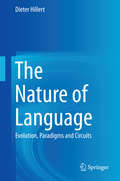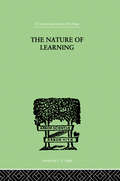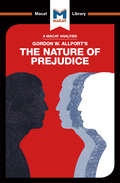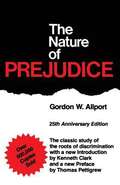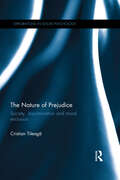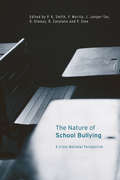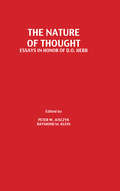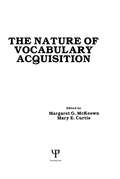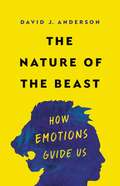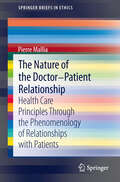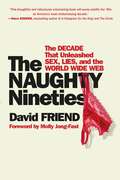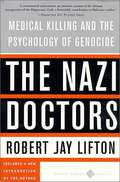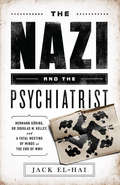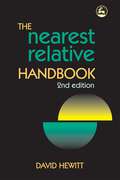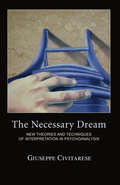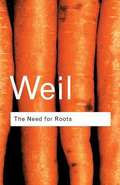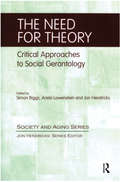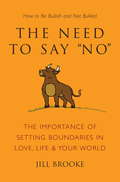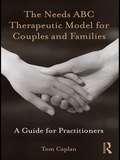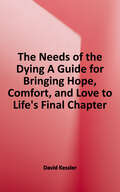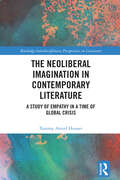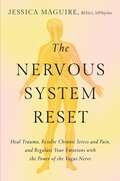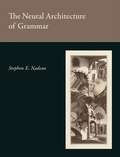- Table View
- List View
The Nature of Language
by Dieter HillertThe Nature of Language addresses one of the most fundamental questions of mankind: how did language evolve, and what are the neurobiological and cognitive foundations of language processing? These questions are explored from different perspectives to discuss the building blocks of language evolution and how they developed in the way they can be found in modern humans. Primarily, neural mapping methods of cognition presented in this research provide extremely valuable data about the neural circuitries that are involved in language processing. Thus, the book explores and illustrates cortical mapping in typical language patterns, but also cortical mapping in atypical populations that fail to process particular language aspects. A neurobiological stance is used to inquire about how language abilities of our species evolved to communicate for the purposes of conveying information such as ideas, emotions, goals, and humor. The evolutionary language model presented builds on the cognitive abilities of our ancestors, and it allows readers to draw a variety of expansive conclusions from that, including the idea that human language as an interface system provides the basis for consciousness.
The Nature of Learning: In Its Relation to the Living System (International Library Of Psychology Ser. #Vol. 41)
by George HumphreyThis is Volume IV in a series of twenty-one in a collection on Cognitive Psychology. Originally published in 1933, this looks at the nature of learning in its relation to the living system. In order to discover the mechanism of the living system, itis necessary to investigate which among its effects are connected with well-established laws of chemistry and physics and to distinguish them carefully from the effects which have no immediate, or at least known, relation with these laws, and of which the cause is concealed for us.
The Nature of Prejudice
by Alexander O’ConnorWith his 1954 book The Nature of Prejudice, American psychologist Gordon Allport displays the crucial skill of reasoning, producing and organizing an argument that was persuasive enough to have a major impact not only in universities, but also on government policy. The question that Allport tackled was an old one: why are people so disposed to prejudice against those from other groups? Earlier psychologists had suggested a number of reasons, especially in the case of racial prejudice. Some had suggested that racism was a learned behaviour, conditioned by negative experiences of other races; others that there was an objective rationale to negative racial stereotypes. Allport, however, reasoned that prejudice is essentially a by-product of the necessary mental shortcuts the human brain uses to process the vast amount of information it takes in. Because our brains want to use as little effort as possible, they regularly fall back on simple stereotypes – which easily generate prejudice. Gathering strong evidence for this hypothesis, he reasoned, clearly and persuasively, that our natural cognitive approach is the most significant factor in accounting for prejudice. Going further still, Allport also reasoned that, once this was better understood, social scientists would be able to influence policy-makers to curb discrimination by law.
The Nature of Prejudice Unabridged 25th Anniversary Edition
by Gordon W. AllportWith profound insight into the complexities of the human experience, Harvard psychologist Gordon Allport organized a mass of research to produce a landmark study on the roots and nature of prejudice. First published in 1954, The Nature of Prejudice remains the standard work on discrimination. Now this classic study is offered in a special unabridged edition with a new introduction by Kenneth Clark of Columbia University and a new preface by Thomas Pettigrew of Harvard University.Allport's comprehensive and penetrating work examines all aspects of this age-old problem: its roots in individual and social psychology, its varieties of expression, its impact on the individuals and communities. He explores all kinds of prejudice-racial, religious, ethnic, economic and sexual-and offers suggestions for reducing the devastating effects of discrimination.The additional material by Clark and Pettigrew updates the social-psychological research in prejudice and attests to the enduring values of Allport's original theories and insights.
The Nature of Prejudice: Society, discrimination and moral exclusion (Explorations in Social Psychology)
by Cristian TileagăThis book offers a critical synthesis of social psychology’s contribution to the study of contemporary racism, and proposes a critical reframing of our understanding of prejudice in European society today. Chapters place a special emphasis on the diversity and intensity of prejudices against Romani people in a liberal, progressive, decent, enlarged Europe. Chapters ask how we can reconcile the European creed of law, justice and freedom for all, with social and political practices that exclude and degrade Romani people. <P><P> This volume addresses the need for a deeper recognition of societal foundations of ideologies of moral exclusion, and calls for a closer and more thorough investigation of prejudices that stem from the societal transformation, diminution or denial of moral worth of human beings (and the various conditions and contexts that create and promote it). By opening new intellectual dialogues, the book reinvigorates a renewed social psychology of racism, and creates a broader foundation for the exploration of the various, active paradoxes at the heart of the social expression of prejudice in liberal democracies. <P><P> The Nature of Prejudice is essential reading for academics, researchers and postgraduate students interested in both the quantitative and qualitative study of discrimination, inequality and social exclusion.
The Nature of School Bullying: A Cross-National Perspective
by P. K. Smith Y. Morita J. Junger-Tas D. Olweus R. Catalano P. SleeThe Nature of School Bullying provides a unique world-wide perspective on how different countries have conceptualized the issue of school bullying, what information has been gathered, and what interventions have been carried out. Written and compiled by well known experts in the field, it provides a concise summary of the current state of knowledge of school bullying in nineteen different countries, including: * demographic details * definitions of bullying * the nature and types of school bullying * descriptive statistics about bullying * initiatives and interventions. The Nature of School Bullying provides an authoritative resource for anyone interested in ways in which this problem is being tackled on a global scale. It will be invaluable for teachers, educational policy makers, researchers, and all those concerned with understanding school bullying and finding ways of dealing with it.
The Nature of Thought: Essays in Honor of D.o. Hebb
by Peter W. Jusczyk and Raymond M. KleinFirst published in 1980. This is a collection of lectures around Professor Emeritus Don O.Hebb of Dalhousie University on the major trends in cognitive psychology. It includes essays on Hebb's ideas and impact on current psychological theorizing; his 'structure of thought', and a collection under the section of 'Information-Processing Analysis'.
The Nature of Vocabulary Acquisition
by Margaret G. McKeown Mary E. CurtisFirst published in 1987. Routledge is an imprint of Taylor & Francis, an informa company.
The Nature of the Beast: How Emotions Guide Us
by David J. AndersonA pioneering neuroscientist offers a new way of understanding how emotions drive behaviorDoes your dog get sad when you leave for the day? Does your cat purr because she loves you? Do bears attack when they&’re angry? You can&’t very well ask them. In fact, scientists haven&’t been able to reach a consensus on whether animals even have emotions like humans do, let alone how to study them. Yet studies of animal emotion are critical for understanding human emotion and mental illness. In The Nature of the Beast, pioneering neuroscientist David J. Anderson describes a new approach to solving this problem. He and his colleagues have figured out how to study the brain activity of animals as they navigate real-life scenarios, like fleeing a predator or competing for a mate. His research has revolutionized what we know about animal fear and aggression. Here, he explains what studying emotions and related internal brain states in animals can teach us about human behavior, offering new insights into why isolation makes us more aggressive, how sex and violence connect, and whether there&’s a link between aggression and mental illness. Full of fascinating stories, The Nature of the Beast reconceptualizes how the brain regulates emotions–and explains why we have them at all.
The Nature of the Doctor-Patient Relationship
by Pierre MalliaThis book serves to unite biomedical principles, which have been criticized as a model for solving moral dilemmas by inserting them and understanding them through the perspective of the phenomenon of health care relationship. Consequently, it attributes a possible unification of virtue-based and principle-based approaches.
The Naughty Nineties: The Triumph of the American Libido
by David FriendA sexual history of the 1990s when the Baby Boomers took over Washington, Hollywood, and Madison Avenue. A definitive look at the captains of the culture wars -- and an indispensable road map for understanding how we got to the Trump Teens.The Naughty Nineties: The Triumph of the American Libido examines the scandal-strafed decade when our public and private lives began to blur due to the rise of the web, reality television, and the wholesale tabloidization of pop culture. In this comprehensive and often hilarious time capsule, David Friend combines detailed reporting with first-person accounts from many of the decade's singular personalities, from Anita Hill to Monica Lewinsky, Lorena Bobbitt to Heidi Fleiss, Alan Cumming to Joan Rivers, Jesse Jackson to key members of the Clinton, Dole, and Bush teams. The Naughty Nineties also uncovers unsung sexual pioneers, from the enterprising sisters who dreamed up the Brazilian bikini wax to the scientists who, quite by accident, discovered Viagra.
The Navigation of Feeling
by William M. ReddyThe Navigation of Feeling critiques recent psychological and anthropological research on emotions. William M. Reddy offers a new theory of emotions and historical change, drawing on research from many academic disciplines. This new theory makes it possible to see how emotions change over time, how emotions have a very important impact on the shape of history, and how different social orders either facilitate emotional life or make it more difficult. This theory is fully explored in a case study of the French Revolution.
The Nazi Doctors: Medical Killing and the Psychology of Genocide
by Robert LiftonIn his most powerful and important book, renowned psychiatrist Robert Jay Lifton presents a brilliant analysis of the crucial role that German doctors played in the Nazi genocide. Now updated with a new preface, The Nazi Doctors remains the definitive work on the Nazi medical atrocities, a chilling exposé of the banality of evil at its epitome, and a sobering reminder of the darkest side of human nature.
The Nazi and the Psychiatrist: Hermann Göring, Dr. Douglas M. Kelley, and a Fatal Meeting of Minds at the End of WWII
by Jack El-HaiIn 1945, after his capture at the end of the Second World War, Hermann Gög arrived at an American-run detention center in war-torn Luxembourg, accompanied by sixteen suitcases and a red hatbox. The suitcases contained all manner of paraphernalia: medals, gems, two cigar cutters, silk underwear, a hot water bottle, and the equivalent of 1 million in cash. Hidden in a coffee can, a set of brass vials housed glass capsules containing a clear liquid and a white precipitate: potassium cyanide. Joining Gög in the detention center were the elite of the captured Nazi regime -- Grand Admiral Döz; armed forces commander Wilhelm Keitel and his deputy Alfred Jodl; the mentally unstable Robert Ley; the suicidal Hans Frank; the pornographic propagandist Julius Streicher -- fifty-two senior Nazis in all, of whom the dominant figure was Gög. To ensure that the villainous captives were fit for trial at Nuremberg, the US army sent an ambitious army psychiatrist, Captain Douglas M. Kelley, to supervise their mental well-being during their detention. Kelley realized he was being offered the professional opportunity of a lifetime: to discover a distinguishing trait among these arch-criminals that would mark them as psychologically different from the rest of humanity. So began a remarkable relationship between Kelley and his captors, told here for the first time with unique access to Kelley's long-hidden papers and medical records. Kelley's was a hazardous quest, dangerous because against all his expectations he began to appreciate and understand some of the Nazi captives, none more so than the former Reichsmarshall, Hermann Gög. Evil had its charms.
The Nearest Relative Handbook: Second Edition
by David HewittWhen a person is subject to the Mental Health Act, many of his or her principal rights are taken away. It is the function of the nearest relative to compensate for that loss. This fully updated second edition explains how the nearest relative is identified, and how in some cases he or she might be displaced. It also contains a wealth of new case examples and illustrative scenarios, providing a succinct discussion of each significant case and incorporating all the very latest changes to the Mental Health Act. The Nearest Relative Handbook will be an invaluable aid to those who find themselves in a professional relationship with a nearest relative, to those who are or wish to be a nearest relative and to anyone needing to make sense of the relevant statutory provisions.
The Necessary Dream: New Theories and Techniques of Interpretation in Psychoanalysis
by Giuseppe CivitareseAfter a hundred years of psychoanalysis, what has the psychoanalytic interpretation of dreams now become? Are what Simic calls "the films of our lives" still the royal road to the unconscious or do we now have a different concept both of dreams and of the unconscious? What is the meaning of dreams in the analytic dialogue? Do they still have a key role to play in clinical practice or not? These are just some of the questions that this book seeks to answer. Nowadays psychoanalysts and psychotherapists do not work so much on dreams as with dreams, preferring to emphasise their function of transformation and symbolic creation, rather than decipher their obscure messages. Dreaming is the way in which we give personal meaning to experience and expand our unconscious. As such, it is a necessary activity which, as Bion says, takes place both in sleep and in waking.
The Need for Roots: Prelude to a Declaration of Duties towards Mankind
by Simone Weil Arthur WillisHailed by Andre Gide as the patron saint of all outsiders, Simone Weil's short life was ample testimony to her beliefs. In 1942 she fled France along with her family, going firstly to America. She then moved back to London in order to work with de Gaulle. Published posthumously The Need for Rootswas a direct result of this collaboration. Its purpose was to help rebuild France after the war. In this, her most famous book, Weil reflects on the importance of religious and political social structures in the life of the individual. She wrote that one of the basic obligations we have as human beings is to not let another suffer from hunger. Equally as important, however, is our duty towards our community: we may have declared various human rights, but we have overlooked the obligations and this has left us self-righteous and rootless. She could easily have been issuing a direct warning to us today, the citizens of Century 21.
The Need for Theory: Critical Approaches to Social Gerontology (Society and Aging Series)
by Jon Hendricks Simon Biggs Ariela LowensteinThe "Need for Theory" speaks to the burgeoning need for critical thinking in social gerontology. The editors have brought together some of the foremost contributors to theoretical advances in the field. This volume incorporates state-of-the-art theorizing with a focus on selected topical areas facing gerontologists around the world. Using their keen insights into substantive issues, the contributors examine personal and structural changes affecting individuals over the life course. Extolling the need for theory is not enough; the contributors focus their insights on a panoply of substantive issues, linking the personal with the political and with the structural parameters that shape the process of aging, no matter where it occurs.
The Need to Say No
by Jill BrookeThe Need to Say No is a simple inspirational guide and instructional manual to help the reader gain command of their relationships by setting boundaries. Whether in love, work, family, or the world, the need to say no is imperative at times. And rather than accepting another transgression or being bullied, learning to set healthy boundaries is essential for our health and well-being at home, in the workplace, or the communities in which we live. The Need to Say No includes helpful advice on how to say no without fear and without injury to either party. It is an essential book for anyone who has said yes too often or just accepted an unacceptable status quo.Emile M. Cioran wrote, "Tyranny destroys or strengthens the individual." Indeed if we allow ourselves to accept a fate without setting boundaries through our will and actions, we can be destroyed emotionally, psychologically, and even physically. Many people have to learn the skills to defend themselves from the inappropriate demands of others, and for that reason The Need to Say No is written. Whether dealing with an abusive love partner, an inappropriate boss, a child that demands everything, a societal condition that needs to stop, or any other kind of bullies, we have the power within ourselves to change the outcomes for the better: to be bullish without being bulldozed. And this better outcome can mean peace at home, success at work, and real change in the world.The Need to Say No uses the metaphor of a bull to examine the behaviors of bullies and boundary violators and also includes mythological, historical and contemporary bull stories and uses them to identify the 10 bull archetypes of aggressive personalities you often encounter and how to deal effectively with them. The Need to Say No provides inspiration and guidance in an entertaining and positive way to help us improve our lives through the decision to say no. Rich with quotes, illustrations, anecdotes, examples, tips, and more this book delivers a profound way to reach a positive conclusion: by saying "no."
The Needs ABC Therapeutic Model for Couples and Families: A Guide for Practitioners
by Tom CaplanThe Needs ABC Therapeutic Model for Couples and Families: A Guide for Practitioners shows readers how to successfully tailor a therapeutic approach to meet the needs of couples and families. Beginning clinicians will come away from this book with concrete, practical skills and expanded theoretical base for their practice. They will be able to apply their new knowledge directly and in ways that will help them create long-lasting change in clients who present with difficult behaviors. The book explains the concepts and theories behind the Needs ABC approach and provides tangible methods with which to integrate aspects of the Needs ABC approach into the therapists' own therapeutic techniques. Practitioners will find that the Needs ABC model is an invaluable complement to cognitive-behavioral, integrative, and other therapeutic models, as well as a general guide to couples and family therapy.
The Needs of the Dying: A Guide for Bringing Hope, Comfort, and Love to Life's Final Chapter
by David Kessler"This book serves the needs of the person sitting by the bedside as much as it does the person who is lying in the bed. In it you will find gentleness and peace in the experience of death." -- Marianne Williamson <p><p>In gentle, compassionate language, The Needs of the Dying helps us through the last chapter of our lives. Author David Kessler has identified key areas of concern: the need to be treated as a living human being, the need for hope, the need to express emotions, the need to participate in care, the need for honesty, the need for spirituality, and the need to be free of physical pain. Examining the physical and emotional experiences of life-challenging illnesses, Kessler provides a vocabulary for family members and for the dying that allows them to communicate with doctors, with hospital staff, and with one another, and—at a time when the right words are exceedingly difficult to find—he helps readers find a way to say good-bye. Using comforting and touching stories, he provides information to help us meet the needs of a loved one at this important time in our lives.
The Neoliberal Imagination in Contemporary Literature: A Study of Empathy in a Time of Global Crisis (Routledge Interdisciplinary Perspectives on Literature)
by Tammy Amiel HouserThis book examines the relationship between empathy and neoliberalism as it unfolded in the aftermath of the 2008 financial crisis and through the turbulent 2010s. Via close readings of contemporary novels, as well as various non-fictional texts, it traces the changing approaches to empathy in the post-financial-crisis imagination, highlighting a crucial re-conceptualization of empathy as a boundaryless force, untethered to local or social circumstance. This reconceptualization implicitly aligns empathy with the neoliberal ethos of globalism and distances it from the traditional notion of “sympathy.” Via complex dialogue with the novelistic tradition of sympathy, contemporary novelists highlight the problematics of boundaryless empathy, while exploring ways to resist neoliberal views and values. Analyzing engagements with empathy in post-2008 literature and culture, the book sheds light on the underlying affective dynamics that enabled the persistence of neoliberalism after the 2008 financial crisis, alongside efforts to challenge its dominance.
The Nervous System Reset: Heal Trauma, Resolve Chronic Pain, and Regulate Your Emotions with the Power of the Vagus Nerve
by Jessica MaguireFrom Vagus nerve expert and the voice behind @repairing_the_nervous_system, a cutting-edge program to heal your nervous system —essential reading for anyone struggling with anxiety, chronic pain, burnout, depression, IBS, PTSD, rheumatoid arthritis, and more. Most of us have heard of the mind-body connection, but did you know that there is a physical structure that connects the mind and body? That connection is the Vagus nerve, and it&’s singularly responsible for maintaining balance in our mental and physical health. In The Nervous System Reset, Jessica Maguire shares the wisdom of her popular Nervous System School masterclasses and shows readers how to unlock the power of their Vagus nerve. Drawing on the science of polyvagal theory and drawing on decades of her own study and coaching experience, Jessica teaches readers neural exercises, breathwork, and somatic practices to widen their window of tolerance in order to… Regulate their emotions Resolve trauma and PTSD symptoms Overcome mental health challenges like anxiety, depression, or burnout Improve symptoms of chronic pain, fatigue, and autoimmune conditions Heal digestive disorders like IBS and SIBO Smart, accessible, and revolutionary The Nervous System Reset is a practical, science-backed program to heal your nervous system for good.
The Nets of Modernism: Henry James, Virginia Woolf, James Joyce, and Sigmund Freud
by Maud Ellmann"One of the finest literary critics of her generation, Maud Ellmann synthesises her work on modernism, psychoanalysis and Irish literature in this important new book. In sinuous readings of Henry James, James Joyce and Virginia Woolf, she examines the interconnections between developing technological networks in modernity and the structures of modernist fiction, linking both to Freudian psychoanalysis. The Nets of Modernism examines the significance of images of bodily violation and exchange - scar, bite, wound, and their psychic equivalents - showing how these images correspond to 'vampirism' and related obsessions in early twentieth-century culture. Subtle, original and a pleasure to read, this book offers a new perspective on the inter-implications of Freudian psychoanalysis and Anglophone modernism that will influence the field for years to come"--
The Neural Architecture of Grammar
by Stephen E. NadeauLinguists have mapped the topography of language behavior in many languages in intricate detail. To understand how the brain supports language function, however, we must take into account the principles and regularities of neural function. Mechanisms of neurolinguistic function cannot be inferred solely from observations of normal and impaired language. In The Neural Architecture of Grammar, Stephen Nadeau develops a neurologically plausible theory of grammatic function. He brings together principles of neuroanatomy, neurophysiology, and parallel distributed processing and draws on literature on language function from cognitive psychology, cognitive neuropsychology, psycholinguistics, and functional imaging to develop a comprehensive neurally based theory of language function. Nadeau reviews the aphasia literature, including cross-linguistic aphasia research, to test the model's ability to account for the findings of these empirical studies. Nadeau finds that the model readily accounts for a crucial finding in cross-linguistic studies--that the most powerful determinant of patterns of language breakdown in aphasia is the predisorder language spoken by the subject--and that it does so by conceptualizing grammatic function in terms of the statistical regularities of particular languages that are encoded in network connectivity. He shows that the model provides a surprisingly good account for many findings and offers solutions for a number of controversial problems. Moreover, aphasia studies provide the basis for elaborating the model in interesting and important ways.
